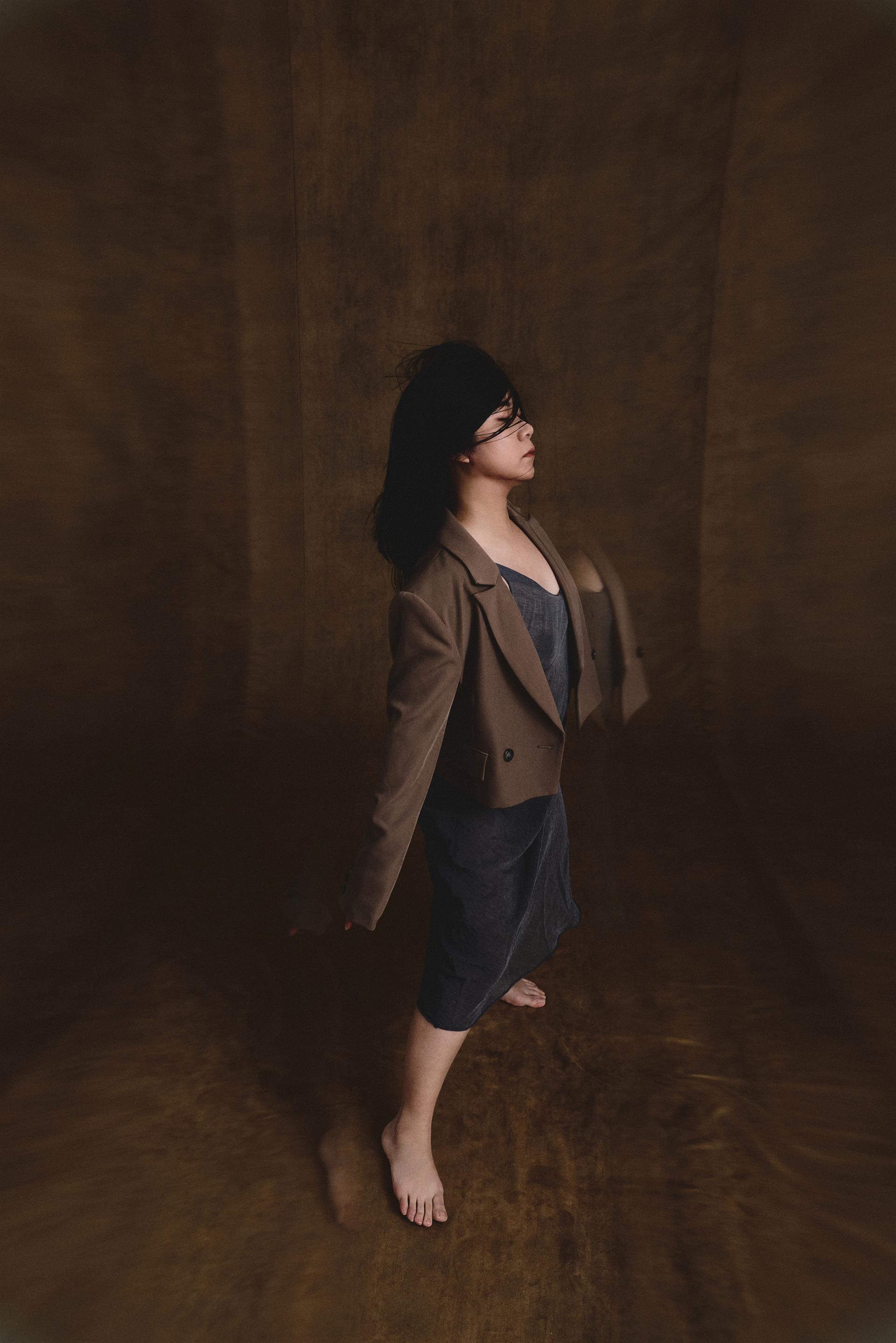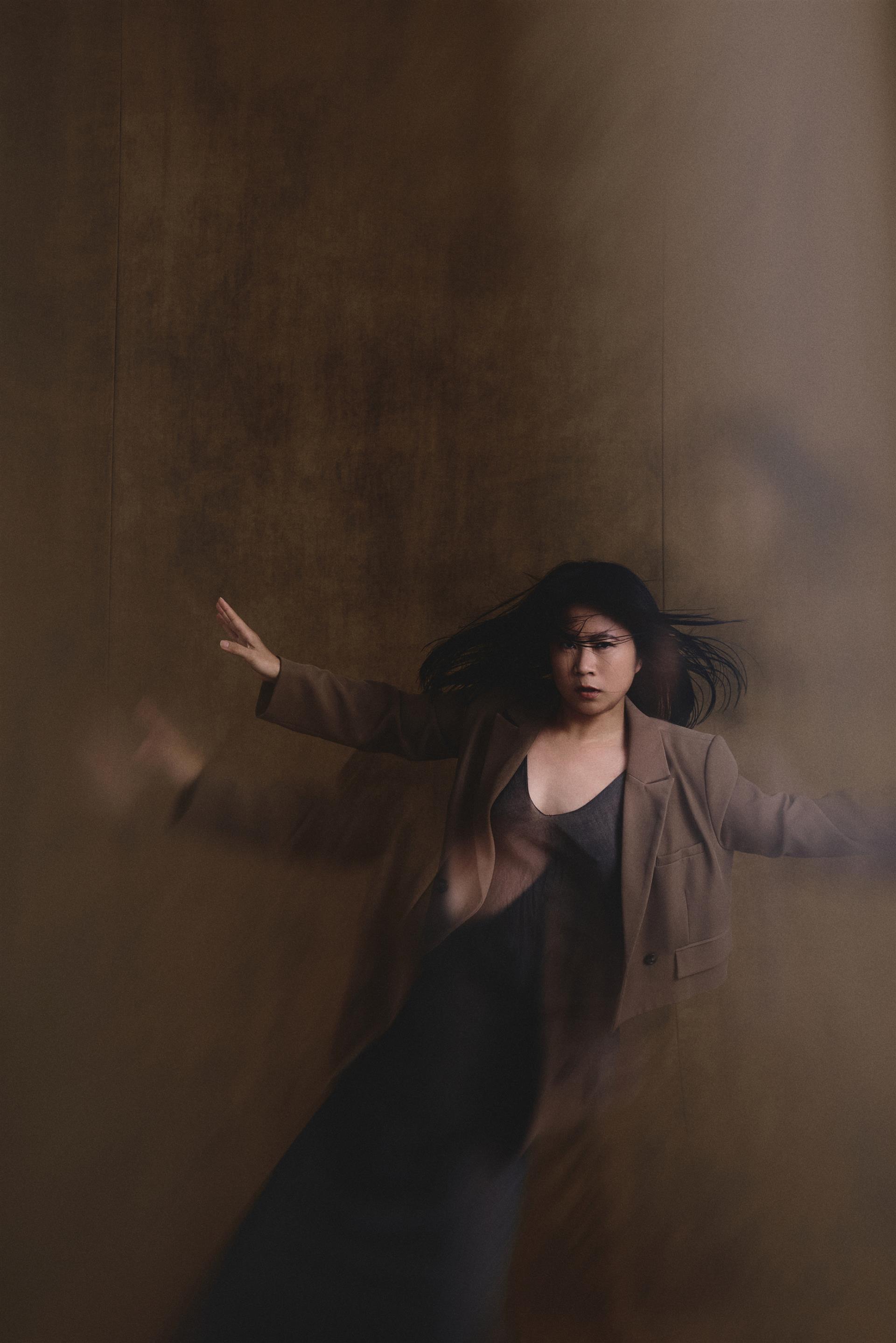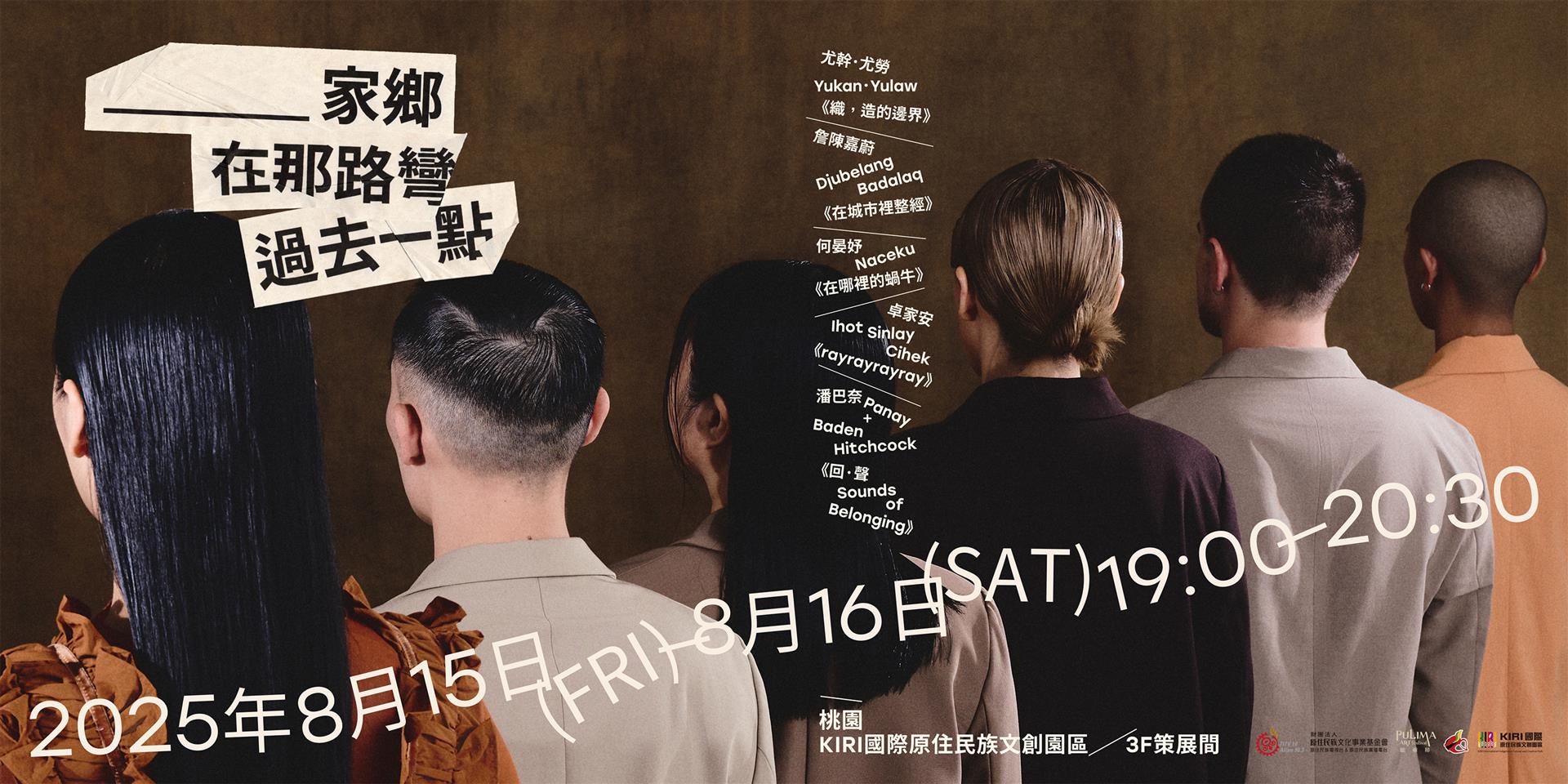在神話與挫傷之間——表演身語與文化回返 (回返代表回來,回到的意思)
花蓮阿美族人,族系來自太巴塱與壽豐部落,現於花蓮與台北兩地游移創作。擁有表演與編劇專業訓練背景,自大學時期即活躍於劇場現場,長年持續實踐各種表演藝術類型,並以表演為思考工具,探索身份、性別與身體哲學的邊界與縫隙。
Ihot的創作深受身份政治與性別理論啟發,2018年起積極回返母系部落文化,聚焦於當代原住民女性身分所經歷的裂解與重構。她關注部落與都市之間、傳統與現代性之間的張力,並透過肢體、文字與表演作為傷痕的顯影術,嘗試為自身所歷的「挫傷」與「蛻化」找尋敘事與出口。其編導演作品《我好不浪漫的當代美式生活》入圍第21屆台新藝術獎,以誠實直白的語言解構文化幻象與性別期待;另一作《神話與笑話》曾入選Pulima表演藝術獎,揉合部落記憶與敘事幽默,呈現自我與文化之間的幽微距離。文字創作,曾榮獲後山文學獎、原住民族文學獎及阿美族語文學獎等肯定。
節目名稱:《rayrayrayray》
作品概念:
《rayrayrayray》是一齣融合台灣阿美族巫術文化、電子聲響藝術與當代心理政治的跨媒體單人行為劇場作品。作品名稱「rayrayrayray」源於阿美族語中的「rayray」,意為「文化」或「傳統」,同時在語音上與漢語「來來」相近,英文拼法則令人聯想到光束(ray)或雷射,象徵跨文化的能量交疊與符號再詮釋。這樣的語言複義性構成了本作創作的核心:文化的召喚,聲音的照明,靈性的閃現。
本作以台灣東部阿美族巫師文化為根基,描繪當代心靈圖像、人類世災難後遺症、電子聲響與科技廢墟美學,構築出一齣發生於未來世界末日廢墟中的演出。透過單人表演者的肢體行動、聲音裝置、燈光與物件使用,展演人在自我療癒的過程中,逐步與看不見的神靈、祖靈與歷史對話,成為一名「因病而巫」的當代女巫,尋求個體的救贖,並在崩解世界中重建文化記憶與靈性連結的行動藝術。
本作採取非線性敘事結構,由多個儀式節點(Ritual Nodes)交錯組成,如同一部來自近未來的精神啟示錄。表演開場,一位直播主 Arongay 與她的虛擬化身 Dungi(曨翼)同時出現於觀眾眼前,在即時互動扮演「回應眾生」的角色。Dungi 被塑造成一位具有神性,同時親切如朋友一般的「女神型VTuber」,以時而詼諧,時而莊重的風格,回應各種對於世界末日、失序現實與孤獨心境的提問。然而,隨著虛擬角色的回應愈顯安定與抽離,Arongay 的身體與情緒卻逐步顯露出崩解的痕跡——她終究無法與觀眾維持等距的距離,也無法像她的分身那般提供確切的慰藉。在現實與虛擬之間,表演者身處一個不斷變動的儀式場域中,既被視為靈媒,也被觀看為脆弱的個體。rayrayrayray常識在科技與靈性的縫隙中,偷窺社群與信仰崩解的時代,人們所尋求的究竟是神的回應,還是一種能夠被凝視與回應的自我實現?
創作動機與概念架構
巫的身體:由「病」而來的身分轉化
在阿美族傳統中,巫師(sikawasay)多半是「不得不」的角色。他們因精神異象、疾病、幻覺、夢境等徵兆,被視為神靈選中的中介者。這種「因病而巫」的邏輯,在當代心理學語境中重新獲得意義:焦慮症、創傷後壓力症候群、憂鬱症、人格解離等,或許正是現代社會中一種超感知能力的潛影。透過對「病」的政治再詮釋,本作思考:當代社會中,誰才是真正的巫?
虛擬直播主:當代「巫術」的靈媒技術?
本作品嘗試以幽默的對比,將動畫直播假借為當代巫術的媒介,實驗虛擬化身如何成為新形態的「神靈顯現」。在偶像與觀眾的即時互動中,情感投射與數位回饋構成一種嶄新的靈性回路,虛擬的角色承載人類對啟示與慰藉的渴望,化身為演算法時代的神諭中介。
虛擬女神的時而語氣冷靜、邏輯明晰,展現出「非人性」的安定;反觀現場演者,在離開直播間時,其情緒與身體卻逐步崩解,顯現心靈失衡的徵候。動畫直播在此不再僅是娛樂形式,隨著末日緊迫,直播彷彿介於信仰與技術之間的儀式機制。作品中角色身份的變異,也使得巫者「不得不」的處境,轉化為當代數位時代中被觀看、被投射、並回應人類焦慮的虛擬中介者——我們抵達人不人、巫不巫、神不神的時代。
In the Space Between Myth and Bruise — Exploring Ritual Embodiment as a Method for Re-measuring the Relational Coordinates with Culture
Ihot Sinlay Cihek is a Pangcah artist from Hualien, rooted in the ancestral territories of Tafalong and Ciamengan. Moving between Hualien and Taipei, she navigates a dual practice as both performer and playwright, crafting a body of work that spans theatre, experimental performance, and embodied research. Since her university years, Ihot has remained deeply engaged with the stage. For her, performance is a kind of knife: a tool that cuts through sedimented identities, gendered inscriptions, and the often-invisible philosophies inscribed in the body. With each gesture and word, she interrogates the fault lines of selfhood and the tensions between tradition and transformation, continually seeking new ways to stage Indigenous memory, presence, and futurity.
Deeply informed by identity politics, gender theory, and decolonial thought, Ihot Sinlay Cihek has, since 2018, increasingly turned her artistic inquiry toward the matrilineal traditions of her Pangcah heritage. Her work arises from the urgent need to reclaim, reimagine, and reweave Indigenous knowledges that have long been marginalized or fractured under settler-colonial modernity. Operating at the intersection of multiple identities—Indigenous and urban, feminine and queer, ancestral and contemporary—she stages performance as a site of resistance and repair.
Through language, movement, and embodied storytelling, Ihot traces the complex trajectories of Indigenous womanhood today—marked by dislocation yet animated by survival. Her practice navigates the frictions between traditional community life and cosmopolitan existence, between inherited cosmologies and the fragmented realities of modernity. Each work becomes an act of decolonial recovery: exposing the bruises left by historical violence, while offering space for ritual, reflection, and the transformative power of performance as both survival and speculation.
Ihot’s recent performance How Romantic: A Guide to Modern Pangcah Life was nominated for the 21st Taishin Arts Award, recognized for its unflinching deconstruction of cultural stereotypes through a potent blend of humor, critical reflection, and performative precision. Her solo piece Myths and Jokes, nominated for the Pulima Performing Arts Award, reconfigures communal memory through storytelling, disrupting fixed narratives with a delicate but incisive use of irony. Both works embody her commitment to destabilizing dominant representational frameworks and reclaiming Indigenous voice through embodied and narrative strategies.
Her writing practice has received multiple honors, including the Houshan Literature Award, the Indigenous Peoples Cultural Foundation’s TIL Award, and the Pangcah Language Literary Award. She approaches language not merely as text, but as a site of struggle and resurgence—where translation, code-switching, and affective register become tools for unsettling epistemic violence and activating cultural continuity.
Ihot的創作深受身份政治與性別理論啟發,2018年起積極回返母系部落文化,聚焦於當代原住民女性身分所經歷的裂解與重構。她關注部落與都市之間、傳統與現代性之間的張力,並透過肢體、文字與表演作為傷痕的顯影術,嘗試為自身所歷的「挫傷」與「蛻化」找尋敘事與出口。其編導演作品《我好不浪漫的當代美式生活》入圍第21屆台新藝術獎,以誠實直白的語言解構文化幻象與性別期待;另一作《神話與笑話》曾入選Pulima表演藝術獎,揉合部落記憶與敘事幽默,呈現自我與文化之間的幽微距離。文字創作,曾榮獲後山文學獎、原住民族文學獎及阿美族語文學獎等肯定。
節目名稱:《rayrayrayray》
作品概念:
《rayrayrayray》是一齣融合台灣阿美族巫術文化、電子聲響藝術與當代心理政治的跨媒體單人行為劇場作品。作品名稱「rayrayrayray」源於阿美族語中的「rayray」,意為「文化」或「傳統」,同時在語音上與漢語「來來」相近,英文拼法則令人聯想到光束(ray)或雷射,象徵跨文化的能量交疊與符號再詮釋。這樣的語言複義性構成了本作創作的核心:文化的召喚,聲音的照明,靈性的閃現。
本作以台灣東部阿美族巫師文化為根基,描繪當代心靈圖像、人類世災難後遺症、電子聲響與科技廢墟美學,構築出一齣發生於未來世界末日廢墟中的演出。透過單人表演者的肢體行動、聲音裝置、燈光與物件使用,展演人在自我療癒的過程中,逐步與看不見的神靈、祖靈與歷史對話,成為一名「因病而巫」的當代女巫,尋求個體的救贖,並在崩解世界中重建文化記憶與靈性連結的行動藝術。
本作採取非線性敘事結構,由多個儀式節點(Ritual Nodes)交錯組成,如同一部來自近未來的精神啟示錄。表演開場,一位直播主 Arongay 與她的虛擬化身 Dungi(曨翼)同時出現於觀眾眼前,在即時互動扮演「回應眾生」的角色。Dungi 被塑造成一位具有神性,同時親切如朋友一般的「女神型VTuber」,以時而詼諧,時而莊重的風格,回應各種對於世界末日、失序現實與孤獨心境的提問。然而,隨著虛擬角色的回應愈顯安定與抽離,Arongay 的身體與情緒卻逐步顯露出崩解的痕跡——她終究無法與觀眾維持等距的距離,也無法像她的分身那般提供確切的慰藉。在現實與虛擬之間,表演者身處一個不斷變動的儀式場域中,既被視為靈媒,也被觀看為脆弱的個體。rayrayrayray常識在科技與靈性的縫隙中,偷窺社群與信仰崩解的時代,人們所尋求的究竟是神的回應,還是一種能夠被凝視與回應的自我實現?
創作動機與概念架構
巫的身體:由「病」而來的身分轉化
在阿美族傳統中,巫師(sikawasay)多半是「不得不」的角色。他們因精神異象、疾病、幻覺、夢境等徵兆,被視為神靈選中的中介者。這種「因病而巫」的邏輯,在當代心理學語境中重新獲得意義:焦慮症、創傷後壓力症候群、憂鬱症、人格解離等,或許正是現代社會中一種超感知能力的潛影。透過對「病」的政治再詮釋,本作思考:當代社會中,誰才是真正的巫?
虛擬直播主:當代「巫術」的靈媒技術?
本作品嘗試以幽默的對比,將動畫直播假借為當代巫術的媒介,實驗虛擬化身如何成為新形態的「神靈顯現」。在偶像與觀眾的即時互動中,情感投射與數位回饋構成一種嶄新的靈性回路,虛擬的角色承載人類對啟示與慰藉的渴望,化身為演算法時代的神諭中介。
虛擬女神的時而語氣冷靜、邏輯明晰,展現出「非人性」的安定;反觀現場演者,在離開直播間時,其情緒與身體卻逐步崩解,顯現心靈失衡的徵候。動畫直播在此不再僅是娛樂形式,隨著末日緊迫,直播彷彿介於信仰與技術之間的儀式機制。作品中角色身份的變異,也使得巫者「不得不」的處境,轉化為當代數位時代中被觀看、被投射、並回應人類焦慮的虛擬中介者——我們抵達人不人、巫不巫、神不神的時代。
In the Space Between Myth and Bruise — Exploring Ritual Embodiment as a Method for Re-measuring the Relational Coordinates with Culture
Ihot Sinlay Cihek is a Pangcah artist from Hualien, rooted in the ancestral territories of Tafalong and Ciamengan. Moving between Hualien and Taipei, she navigates a dual practice as both performer and playwright, crafting a body of work that spans theatre, experimental performance, and embodied research. Since her university years, Ihot has remained deeply engaged with the stage. For her, performance is a kind of knife: a tool that cuts through sedimented identities, gendered inscriptions, and the often-invisible philosophies inscribed in the body. With each gesture and word, she interrogates the fault lines of selfhood and the tensions between tradition and transformation, continually seeking new ways to stage Indigenous memory, presence, and futurity.
Deeply informed by identity politics, gender theory, and decolonial thought, Ihot Sinlay Cihek has, since 2018, increasingly turned her artistic inquiry toward the matrilineal traditions of her Pangcah heritage. Her work arises from the urgent need to reclaim, reimagine, and reweave Indigenous knowledges that have long been marginalized or fractured under settler-colonial modernity. Operating at the intersection of multiple identities—Indigenous and urban, feminine and queer, ancestral and contemporary—she stages performance as a site of resistance and repair.
Through language, movement, and embodied storytelling, Ihot traces the complex trajectories of Indigenous womanhood today—marked by dislocation yet animated by survival. Her practice navigates the frictions between traditional community life and cosmopolitan existence, between inherited cosmologies and the fragmented realities of modernity. Each work becomes an act of decolonial recovery: exposing the bruises left by historical violence, while offering space for ritual, reflection, and the transformative power of performance as both survival and speculation.
Ihot’s recent performance How Romantic: A Guide to Modern Pangcah Life was nominated for the 21st Taishin Arts Award, recognized for its unflinching deconstruction of cultural stereotypes through a potent blend of humor, critical reflection, and performative precision. Her solo piece Myths and Jokes, nominated for the Pulima Performing Arts Award, reconfigures communal memory through storytelling, disrupting fixed narratives with a delicate but incisive use of irony. Both works embody her commitment to destabilizing dominant representational frameworks and reclaiming Indigenous voice through embodied and narrative strategies.
Her writing practice has received multiple honors, including the Houshan Literature Award, the Indigenous Peoples Cultural Foundation’s TIL Award, and the Pangcah Language Literary Award. She approaches language not merely as text, but as a site of struggle and resurgence—where translation, code-switching, and affective register become tools for unsettling epistemic violence and activating cultural continuity.
Program Title: rayrayrayray
rayrayrayray is a cross-media solo performance that merges Pangcah ritual knowledge, electronic sound art, and speculative psycho-political reflection. Staged as a post-technological shamanic ritual, the work explores how systems of belief, devotion, and healing persist and mutate across contexts—from Indigenous shamanism to contemporary fan culture.
The title, drawn from the Pangcah word rayray (referring to cultural history), becomes a sonic incantation when repeated—echoing the Mandarin “來來” (lai lai, “come, come”) and resembling the English word “ray,” a trace of light or spectral presence. This linguistic polyphony frames the work’s core: a summoning of history, a search for connection, and a flickering emergence of faith.
Performed by a solo figure who inhabits both physical and virtual realms—including a VTuber avatar—the piece unfolds as a techno-ritual where AI-generated chants, modular soundscapes, and audience interaction coalesce. rayrayrayray asks: in a world saturated with algorithms and disembodied affect, can new forms of belief still heal? Can digital ritual re-enchant the fractured present?
Rooted in the sikawasay practices of Indigenous peoples in eastern Taiwan—particularly the Pangcah—this performance summons a techno-spiritual ritual where ancestral memory and post-human aesthetics intersect. Engaging themes of mental illness, post-catastrophe trauma, and fragmented electronic soundscapes, the work unfolds within a dystopian ruin.
Through the body of the performer—engaged with sound devices, minimal ritual objects, and fluctuating light—a space of invocation is opened. She becomes a contemporary shaman: one who, through psychic rupture and spiritual sensitivity, enters into communication with what is unseen.
The performance reflects on the affective conditions of modern life: isolation, anxiety, and the desperate search for meaning in algorithmic time. Between code and breath, between data and devotion, rayrayrayray asks whether new forms of belief—anchored in both Indigenous cosmology and contemporary fan culture—might still offer healing in an era of spiritual exhaustion.
This work unfolds through a non-linear narrative structure composed of multiple ritual nodes, forming what may be read as a spiritual apocalyptic text from a near-future horizon. At the opening of the performance, a livestreamer named Arongay appears alongside her virtual double, Dungi, a VTuber avatar whose function is to “respond to the masses” in real time. Dungi is crafted as a divine-yet-familiar figure—a goddess-like entity rendered with the accessibility of an online friend. Her tone oscillates between playful and solemn, offering comfort to an audience unsettled by the end of the world, disintegrating realities, and the aching weight of loneliness.
Yet as the virtual persona grows more composed and emotionally detached, the physical body of Arongay begins to unravel. She cannot maintain the distance her avatar effortlessly embodies, nor can she deliver the spiritual reassurance her audience seeks. Suspended between virtuality and flesh, the performer inhabits an unstable ritual field—at once seen as a medium and exposed as a fragile human subject.
rayrayrayray operates within the fissures between technology and belief, where ritual, fandom, and digital intimacy coalesce. It quietly observes the disintegration of collective faith and asks: in an age of spiritual exhaustion and mediated connection, are we still seeking divine answers—or simply the possibility of being seen, and answered, at all?
Motivation and Conceptual Framework
The Shamanic Body: Illness as a Threshold of Transformation
In traditional Pangcah cosmology, the sikawasay—the shaman—is often a role assumed out of necessity rather than choice. Marked by spiritual disturbances, illness, visions, or dreams, these individuals are perceived as being chosen by ancestral or elemental forces to serve as intermediaries between worlds. This logic of becoming a shaman “through illness” acquires renewed significance within the vocabulary of contemporary psychology: anxiety disorders, post-traumatic stress, depression, and dissociative identity phenomena may, in fact, be latent forms of heightened perception within modernity’s disenchanted frameworks. By politically reinterpreting the notion of “illness,” this work interrogates a central question: In today’s world, who is the true “sikawasay”?
VTubers as Contemporary Shamans? Animistic Mediation in the Age of Live Animation
This work explores live animation as a medium of contemporary sorcery, positing the virtual avatar as a newly configured site of divine revelation. Within the affective circuits of idol-fan interaction, emotional projection and algorithmic feedback generate a ritual feedback loop—one in which the virtual figure becomes a surrogate oracle for an era governed by code, screens, and longing.
The virtual goddess speaks with calculated composure and algorithmic clarity—her voice marked by a nonhuman serenity. In contrast, the live performer behind the avatar gradually unravels, her body and psyche exhibiting signs of spiritual dissonance once the stream ends. Here, live animation exceeds its function as entertainment: it becomes a techno-spiritual apparatus that mediates crisis, intimacy, and the precarity of belief.
As the specter of apocalypse looms, the boundaries between faith and interface, between ritual and transmission, collapse. The shamanic role—once assumed through illness or spiritual calling—is reconfigured through the gaze of the livestream. In this moment, we encounter a figure that is no longer fully human, nor entirely divine: a reluctant medium produced by the anxieties of the digital age.
延伸閱讀:
➤ 專訪|卓家安 Ihot Sinlay Cihek



